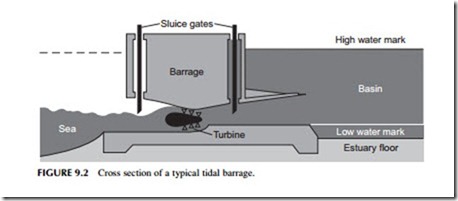TIDAL POWER PLANT DESIGN
The main component of any tidal barrage power plant is the dam or barrage that is built across the mouth of a tidal estuary or inlet. This barrage is fitted with special sluice gates that are opened and closed during different stages of the tide. It is also fitted with hydropower turbines, and these too are equipped with gates so that seawater can either be allowed to pass through them or prevented from doing so as the tide changes (Figure 9.2).
The simplest and most common form of power generation with a tidal bar- rage is ebb-generation. Under this scheme water is allowed to pass from the sea
across the barrage and into the lagoon or basin behind it as the tide rises. Once high tide has been reached, the sluice gates within the barrage are shut, trapping the seawater within the lagoon.
The tide is now allowed to fall on the seaward side of the barrage to create a head of water across the barrage that will drive the trapped water through the hydro-turbines. The length of time during which the water is held will depend on the specific project but will normally be until the tide has fallen to around half its tidal range. At this point the gates closing the turbines are opened, allowing the water from the lagoon to flow through them and back to the sea. Generation will normally continue until close to or after low tide.
When generation stops, the gates protecting the turbines are closed again and the sluice gates opened so that as the tide turns, water will once again pass the barrage into the lagoon. The cycle is then repeated through the next tide.
It is possible to reverse the mode of operation and generate power on the flood tide instead of the ebb tide. In this case the sluice gates are kept closed at low tide so that no water can pass. When the tide has risen by about half its range the turbine gates are opened, allowing water to flow through them and into the lagoon, generating power in the process. Generation continues until levels on either side of the barrage are similar when the turbine gages are closed and the sluice gates opened, permitting the lagoon to empty again. While this is operationally simply ebb-generation in reverse, it is not commonly employed because it leaves the tidal basin behind the barrage exposed to low-tide conditions for extended periods, a situation that can have dam- aging environmental effects. (However, the particular conditions at the Sihwa tidal barrage plant in South Korea have made this mode of operation preferable.)
It is also possible to generate power during both the ebb and flow tide. The French plant at La Rance was designed to operate in this way but the plant in fact only operates in ebb-generation mode. The main problem with two-way generation is that calculations suggest that economic gains are small and unlikely to be cost effective because it necessitates the additional expense of either two- way turbines or two sets of turbines, one for each direction. On the other hand, it allows generation to take place for much more of the tidal cycle and leads to an overall lower peak power since the head of water that develops is never as high as with single-direction operation. This would in principle allow smaller turbines to be used.
A further operational mode, one that has been employed at La Rance in France, is to use the turbines as pumps to pump additional water across the bar- rage. Pumping takes place at close to high tide, creating a larger head of water than would be available from the tidal range alone. It is possible to generate up to 10% more power using pumping than without it, and the economics are attractive since the pumping takes place when the head height across the barrage is very small, therefore requiring little additional energy while energy is returned from a much higher head.
